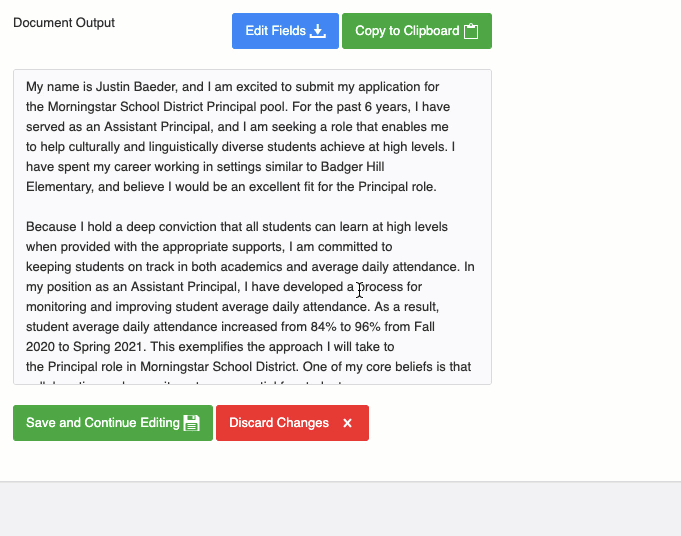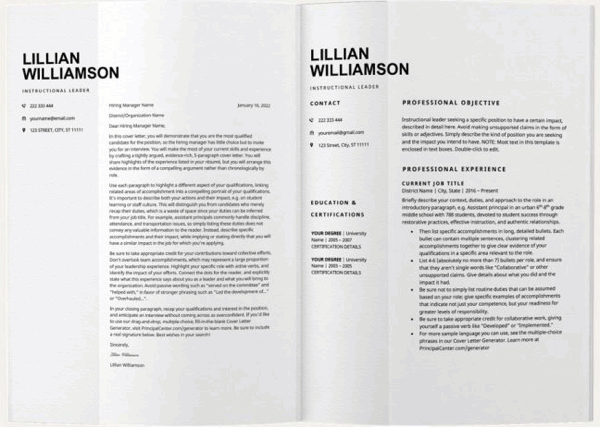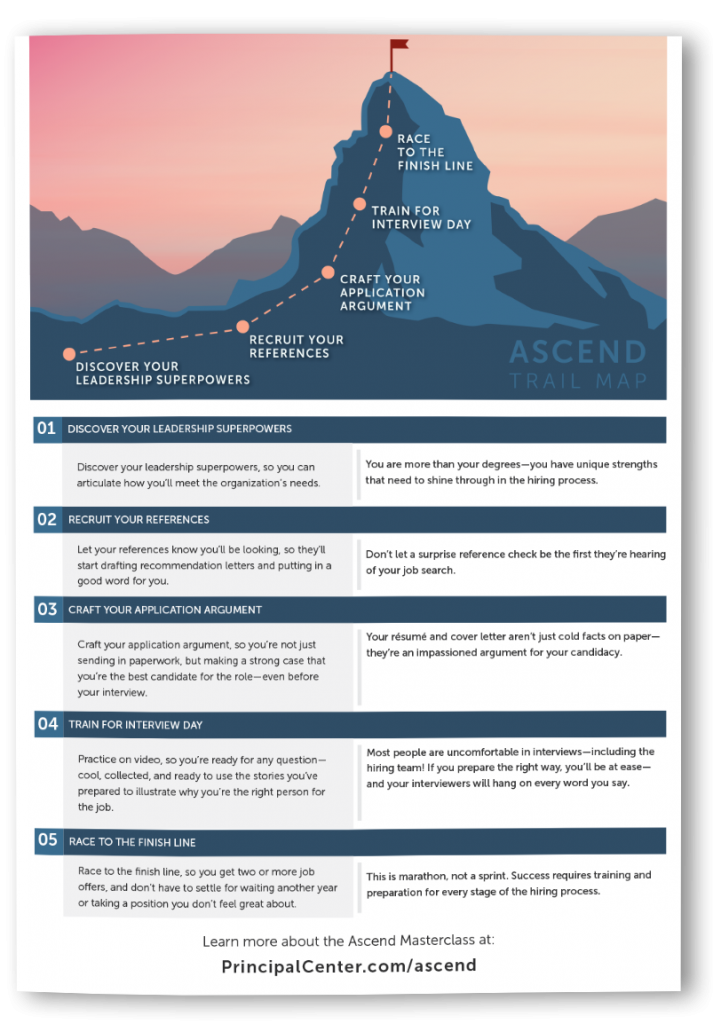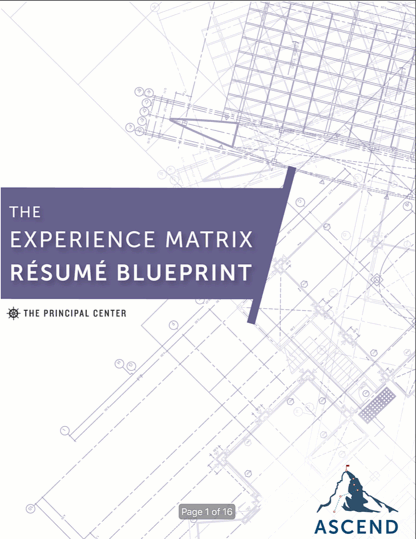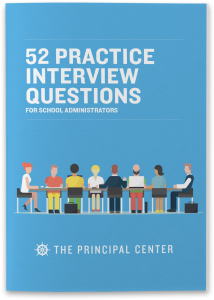by Justin Baeder, PhD
If you're looking for a new ed leadership job, a critical first step is to put together a cover letter that crushes it.
Cover letters aren't always required, and sometimes people make the mistake of thinking they're just a formality—something to “cover” the résumé. This couldn't be farther from the truth.
Here's how cover letters really work, and how you can rise above the competition so you get more interviews.

The Cover Letter's Job
Your cover letter is NOT a mere formality; it's an argument that you deserve an interview.
If your cover letter fails to do its job—getting you in the “TO INTERVIEW” pile—the whole process stops. You're out of the running.
Preparing for interviews? Download our practice interview questions and 10-point self-assessment rubric.
You don't get to shine in an interview. Your references don't get a chance to put in a good word. You just go in the “NO” pile.
You can only write a solid cover letter if you understand its purpose. Your cover letter is NOT:
- An explanation of the simple fact that you exist and are interested in the position
- A narrative restatement of your résumé—a sheet to “cover” it
- A note to the reader that you possess the minimum legal requirements for the position
Cover letters that only cover the basics don't give the reviewer any useful information. They fail to do their job…so you fail to get your job.
To do its job effectively, your cover letter needs to be a tightly constructed, evidence-packed 5-paragraph essay.
The 5-Paragraph Essay Format
The body of your cover letter will look like the 5-paragraph essays you wrote as a student:
- Introductory paragraph orienting the reader and summarizing your argument
- First body paragraph, making an evidence-driven argument about your qualifications in a specific area
- Second body paragraph, making an evidence-driven argument about a 2nd specific area of practice
- Third body paragraph, focused on a 3rd specific area of practice
- Conclusion paragraph, recapping your argument that you are highly qualified for the position
Choose the topics of your body paragraphs by focusing on the chief areas of responsibility for the job and the accomplishments you want to highlight.
For example, body paragraphs in a cover letter for a high school principal position might focus on:
- Students, culture, and climate
- Staff, professional growth, and instructional leadership
- Parent and community engagement
In each paragraph, make a strong claim about your leadership, then back it with evidence. For example, here's a paragraph built with our drag-and-drop, fill-in-the-blank Cover Letter Generator:
Because I hold a deep conviction that all students can learn at high levels when provided with the appropriate supports, I am committed to keeping students on track in both academics and average daily attendance. In my position as an Assistant Principal, I have developed a process for monitoring and improving student average daily attendance. As a result, student average daily attendance increased from 84% to 96% from Fall 2024 to Spring 2025. This exemplifies the approach I will take to the Principal role in Morningstar School District. One of my core beliefs is that collaboration and commitment are essential for student success.
A strong body paragraph:
- Gives a sense of who you are and what you believe
- Identifies a specific area of responsibility in which you have strengths
- Describes specific accomplishments in that area
By constructing your argument piece by piece, you can send an unmistakable message:
“I'm better-qualified than the competition.”
Of course, you can't say that directly, but you won't need to. The evidence will speak for itself—but only if you present it effectively.
The Ascend Cover Letter Generator has 22 fill-in fields that you can customize, which are incorporated into more than 30 multiple-choice phrase blocks.
Formatting Tips for Principal & AP Cover Letters
Here are a few formatting suggestions to help the reader focus on your letter's argument.
- Limit your cover letter to one page, but use the full page—you'll want to make as strong an argument as possible.
- Use an easy-to-read and common font like Times New Roman or Calibri, and always submit it as a PDF rather than Word or Google Docs file in order to preserve your formatting.
- Use a reasonable font size—11 or 12 point—and margins between 0.75 and 1″ on all sides.
In addition, since it's a letter, you'll want to have:
- Your contact information at the top—name, email, and cell phone
- The recipient's contact information and a salutation addressing this recipient, e.g. “Dear Wayside School Principal Hiring Committee”
- Your scanned signature and printed name at the bottom
Template Pitfalls
If you choose to use a template, here are some things to watch out for:
- Do NOT include a photo—while standard in some professions, a candidate photos is considered unprofessional in educational leadership
- Avoid overly graphical or wacky designs—some résumé templates are designed by graphic designers for graphic design jobs, but effective principal and assistant principals résumés are more reserved and professional in style
- It's fine for your cover letter to be plain text, but if you use a template, make sure it matches your résumé template—here are 10 samples to inspire you
Don't Be Perfunctory—Sell Yourself As An Educational Leader
This is hard for us to do as educators, but in your cover letter, you've got to sell yourself as hard as you ever will.
This doesn't mean that you:
- Brag or boast
- Make unsupported claims
- Explicitly say that you're the best person for the job
…but you need to make the reader come to the inevitable conclusion that you're the best person for the job.
One way to make your argument more compelling is to emphasize your beliefs and commitments, then follow them with specific accomplishments.
For example, here are some phrases you can use to begin a paragraph with a strong statement of belief or commitment:
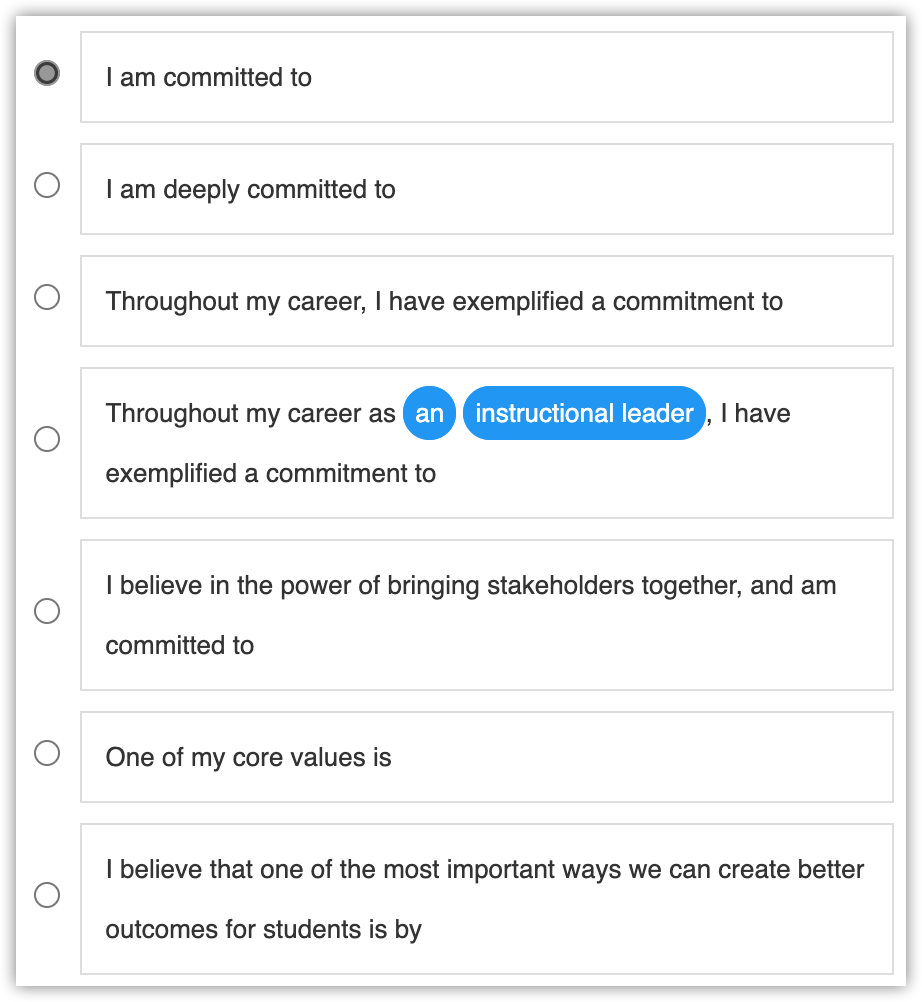
Avoid Adjectives, Skills, and Other Unsupported Claims
Strengthen your argument with specific claims and evidence, and weed out any unsupported claims that aren't backed with rock-solid examples.
One especially problematic type of claim is adjectives describing yourself and your skills, like:
- Transformational
- Collaborative
- Dedicated
Even if these adjectives seem to describe desirable traits, they harbor a fatal flaw: they're unsupported claims.
What does it even mean to be a “transformational” leader? How would the reader evaluate such a claim?
The key is to show, not tell—provide evidence about the kind of leader you are, instead of making claims that will trigger the reader's skepticism.
- Connect the dots for the reader—always explain how the qualifications you're highlighting actually make a difference.
For example: “My six years of experience working with teachers as an instructional coach have equipped me to be an effective instructional leader as an assistant principal “ - Don't mention meeting minimum qualifications, e.g. principal certification. Basic information like this should already be described in your résumé, and doesn't bear repeating in your cover letter. Emphasizing how you meet the job's minimum requirements will draw attention away from your accomplishments and make you look less qualified.
- Frame your qualifications in terms of benefits for the organization, and especially for its students, and include quantitative results if you. have them, e.g. “My passion for supporting students who struggle with their behavior compelled me to lead the development of a behavior intervention program that reduced out-of-school suspensions by 63%.”
In other words, don't just share facts that are in your résumé (and certainly don't share facts that don't make you stand out). Emphasize your accomplishments that make you rise above the competition.
Evaluate Your Cover Letter's Performance with the 20% Rule
How will you know if your cover letter is good enough? Here's how to evaluate it.
Before you apply, make sure you've put in enough effort to have a good chance of success.
First, if you've spent less than 10 hours on your cover letter, it is probably not good enough. Revision is the only way to turn a first draft into a true competitive advantage—and remember, if you don't get past paper screening, you'll never have a chance to shine in an interview.
Second, make sure you've run your cover letter by someone you trust—a family member, mentor, or trusted friend. It's hard to know whether you're over- or under-selling yourself, and hard to tell if your wording makes sense after you've been staring at it for hours.
Third, print it out in hardcopy and proofread it with a pen—you'll find mistakes that you've stopped seeing onscreen.
Once you've put in enough effort, you're ready to try it in the real world—by applying for jobs.
If you land an interview for 1 out of 5 jobs you apply for, your cover letter is doing a decent job.
This is known as the 20% Rule: if you succeed at a given stage of the job search 20% of the time or more, you probably don't have much more room for improvement.
It's easy to take every rejection as a sign that something is wrong, but that's not the right way to think about the school administrator job search. It's highly competitive, with many applicants for every position.
At each stage of hiring, most of the candidates have to be eliminated, with only a few going on to the next round. If you're succeeding less than 20% of the time, strive to improve your performance at that stage.
To get an overview of the entire job search, check out the Ascend Trail Map.
Start Strong with the Ascend Cover Letter Generator
To start with a proven structure for admin cover letters, use the Cover Letter Generator, our drag-and-drop, multiple-choice, fill-in-the-blank app for writing a powerful cover letter that gets you more interviews.

Follow The Résumé Blueprint
Once your cover letter is in great shape, make sure your résumé is equally strong.
An effective résumé contains these specific sections, with no unsupported claims like “skills” or a “candidate profile.”
Practice for Interviews
Even as you're working on your cover letter and résumé, it's not too soon to begin preparing for interviews.
Download our 52 Practice Interview Questions here—they're free, and have helped more than 10,000 school leaders prepare for interviews.

About the Author
Justin Baeder, PhD is Director of The Principal Center, where he helps senior leaders in K-12 organizations build capacity for instructional leadership by helping school leaders:
- Confidently get into classrooms every day
- Have feedback conversations that change teacher practice
- Discover their best opportunities for student learning
He holds a PhD in Educational Leadership & Policy from the University of Washington, and is the host of Principal Center Radio, where he interviews education thought leaders.
His book Now We're Talking! 21 Days to High-Performance Instructional Leadership (Solution Tree) is the definitive guide to classroom walkthroughs.

